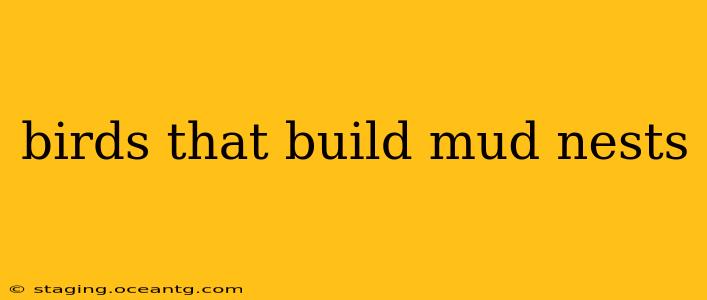Many bird species utilize mud as a key component in their nest construction, showcasing incredible ingenuity and adaptation to their environments. Mud provides a strong, stable base and can help regulate temperature, making it a valuable building material in diverse habitats. This guide explores various bird species that incorporate mud into their nest building, highlighting their unique techniques and the fascinating reasons behind their choices.
What kinds of birds use mud to build nests?
Several bird families employ mud in their nest building, each with its own specific methods and nest structures. Common examples include swallows (Hirundinidae), ovenbirds (Furnariidae), and some species of wrens (Troglodytidae). The exact species that utilize mud can vary depending on geographical location and available resources. For example, while the Northern Rough-winged Swallow is known for its mud nests throughout North America, you'll find different swallow species utilizing similar techniques in other parts of the world.
How do birds collect and use mud for their nests?
The process of mud nest construction is remarkably intricate. Birds typically collect mud in their beaks, often adding other materials like twigs, grass, or saliva to create a cohesive mixture. The consistency of the mud is carefully managed to ensure optimal structural integrity. Some species, like the Cliff Swallow, build elaborate nests with numerous chambers, demonstrating impressive engineering skills. Others might create simpler cup-shaped structures, perfectly suited to their needs. The addition of saliva acts as a natural binding agent, strengthening the mud and making it waterproof.
What are the advantages of using mud in nest building?
The use of mud offers several key advantages for birds. First, mud provides a sturdy foundation, resisting strong winds and rain. This is particularly crucial for birds nesting in exposed locations, such as cliffs or banks. Second, mud nests offer excellent insulation, helping regulate the temperature inside, vital for protecting eggs and chicks. Finally, mud can be readily available in many environments, making it a convenient and accessible building material.
What are the disadvantages of using mud in nest construction?
While offering many benefits, mud nest building also presents some challenges. The drying process can be time-consuming, and the weather can significantly impact the construction timeline. Heavy rainfall can damage partially completed nests, forcing birds to start over. Furthermore, the weight of mud nests can limit the placement options for birds, restricting them to locations that can support the structure's weight.
Do all mud nests look the same?
No, mud nests exhibit a remarkable diversity in shape, size, and complexity, reflecting the specific needs and behaviors of each species. Cliff Swallows create intricately sculpted nests clustered together on cliff faces, while other species, such as the Brown Thrasher, build simpler, cup-shaped mud nests concealed within dense vegetation. This variation underscores the adaptability and innovation within bird communities.
Are mud nests difficult to build?
The difficulty of building a mud nest varies significantly across species. Some species, like the Cliff Swallow, create remarkably complex structures, requiring significant time and effort. Others construct simpler nests with less demanding structural requirements. The complexity of the nest is often related to the bird's nesting habits and environmental conditions.
What materials do birds use besides mud in their nests?
While mud forms the primary structural element in many nests, birds often incorporate other materials to enhance the nest's functionality and appearance. Common additions include grass, twigs, leaves, feathers, and even small pieces of string or cloth, depending on the availability of resources in their environment. These supplemental materials add insulation, cushioning, and structural reinforcement to the mud base.
This exploration of birds that build mud nests demonstrates the remarkable ingenuity and adaptation within the avian world. The variety of techniques, nest designs, and materials used highlight the rich diversity of bird behaviors and their fascinating relationship with their environment. Further research into specific bird species will uncover even more fascinating details about these remarkable structures.
